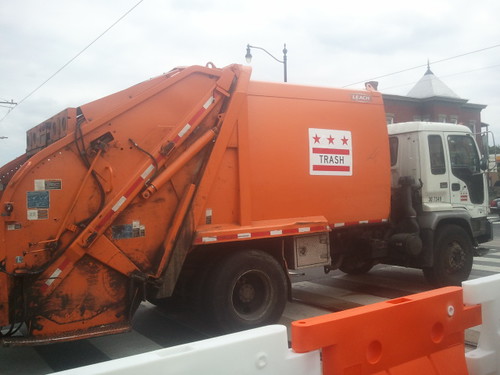A DC government example of "branded communications"
The city's sanitation trucks have added the DC flag to the sides of the truck. I've argued for years that the city should use sanitation trucks as rolling billboards to communicate environmental messages.
I don't think the flag+the word trash was what I had in mind. (The city government has a ways to go before one could say it understands "social marketing," "graphic communications," "the design method," and branding.)

From an old blog entry:
Repositioning municipal solid waste functions
It's probably better as a separate entry, but municipal solid waste operations ought to reposition how they operate. The "Every Litter Bit Hurts" entry discusses how the City of Johannesburg did this with their "Pikitup" solid waste collection outfit (which is another illustration of the "action planning" approach I tout, in large part to extend the life of their landfills).
 Baltimore has a good social marketing program (see the webpage from the agency, Planit, that produced the campaign) with regard to litter, and they use some of their garbage trucks as rolling billboards--I wonder why more cities don't do this?
Baltimore has a good social marketing program (see the webpage from the agency, Planit, that produced the campaign) with regard to litter, and they use some of their garbage trucks as rolling billboards--I wonder why more cities don't do this?Action planning
It extends my interpretation of best practice transformational planning, which I had previously discussed in this entry, "Social Marketing the Arlington (and Tower Hamlets and Baltimore) way," into an integrated framework that I am now calling "Action Planning."
Action planning takes the ideas of advocacy planning and marries to it the concept of action research to transform planning more towards being concerned about implementation and making things happen.
In a slide in the presentation (below) entitled "Action Planning as systems integration" I argue that Action Planning is a framework with five inter-connected components:
1. Design Method rather than Rational Planning
2. Social Marketing
3. Integrated Program Delivery System
4. Packaged through Branding & Identity Systems
5. Civic Engagement & Democracy at the foundation = citizen at the center
Another way to think about municipal solid waste programming is in terms of what is called the "product-service system" or platforms
The United Nations Environmental Program has pushed this concept with regard to sustainability and waste reduction. See for example the report, Product-Service Systems and Sustainability.
The concept of platforms and the product-service system is the foundation for "collaborative sharing" systems like car sharing.



0 Comments:
Post a Comment
<< Home